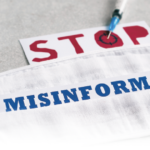 My children were playing in the car the other day and pulled open the glove box. Inside, they found a brown paper bag with my last name “KUMAR” in black Sharpie and a red sticker that read, “Do not lose. No replacements available.” It wasn’t long before the kids tore that bag apart to find the treasure inside. They were a little disappointed that it was only a blue-green N95 mask, but in the year 2020, it may have well been worth its weight in gold and diamonds.
My children were playing in the car the other day and pulled open the glove box. Inside, they found a brown paper bag with my last name “KUMAR” in black Sharpie and a red sticker that read, “Do not lose. No replacements available.” It wasn’t long before the kids tore that bag apart to find the treasure inside. They were a little disappointed that it was only a blue-green N95 mask, but in the year 2020, it may have well been worth its weight in gold and diamonds.
It’s hard to realize that it has been five years since COVID-19 came to our shores. It seems simultaneously like yesterday and also many decades ago. The panic, the lockdowns, the social bubbles, the store shortages—they seem almost quaint in retrospect. With today’s certainty of knowing that we have survived the past, that era almost seems nostalgic. After all, we were able to spend time away from our workplaces with the people that we cared about the most. However, as I tugged at the rubber strings of the N95 mask, that nostalgia faded away to a more sobering reality.
What has five years of the COVID-19 pandemic taught us? Let’s rheuminate.
Grief & Persistence
Unfathomable grief defined those early weeks, months and years of the pandemic. I remember calling my parents and relatives, fearing they might be stricken if they weren’t careful.
Our grief was sometimes even anticipatory: I recall one text message from a rheumatologist colleague who said, “Things are bad here. I don’t know when my turn will come.”
The omnipresence and intimacy of these thoughts change you and force you to look deep into the soul.
We experienced more than the anticipatory grief and collective mourning for those who died. The numbers creeping up and maps turning redder and redder told only part of the story. We also grieved for the loss of normalcy, routine and certainty.
Once our initial lockdowns eased up, every rheumatology clinic became quieter, not just because of fewer in-person visits, but because of the weight that each encounter carried. Patients arrived (online) more anxious, acutely aware that their medications could make them more vulnerable to a virus the world barely understood.
For too many of us, the grief was deeply personal. We lost loved ones, jobs and social connections. Grief is rarely static. Yet it morphed into persistence—a defiance of this invader into our lives. I saw it in the patients who attended virtual visits, holding their smartphones at awkward angles to show swollen joints. I saw it in colleagues who juggled childcare, research and clinical duties while wearing masks for hours on end. Surprisingly, grief didn’t paralyze us; it mysteriously propelled us forward, forcing us to adapt to a world in which uncertainty became the only certainty.



